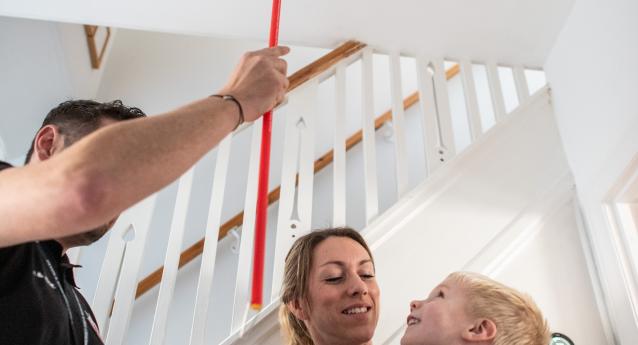Fire safety advice for parents and guardians
Households with children can be at a higher risk of fire. Read our advice to stay safe from fire, and help young children understand what to do, and what not to do.
This page will help you understand:
- how to reduce the risk of fires starting
- where to put smoke alarms and how to use them
- how to escape from a fire.
It’s also important to have sensible and age-appropriate conversations with children to help them to understand the risks of fire, and what to do if there is a fire at home.
Know what to do in a fire
No one likes to think that a fire might start, but being prepared can make all the difference. Don’t take any risks and don’t try to tackle the fire.
Make sure everyone in your home remembers to:
- get out
- stay out
- call 999.
Prevent a fire from starting
There are many simple ways you can reduce your risk of a fire starting in the first place. Here are some top tips for households with children.
- Take extra care with cooking and don’t get distracted. More than half the house fires we attend start in the kitchen.
- We know there’s a lot of washing (and washing up) when it comes to children. Never leave your washing machine, tumble dryer, or dishwasher on when you’re out of the house, or at night. Read about a family in Barnstaple whose tumble dryer caused a fire.
- Keep fire-lighting material such as matches and lighters out of the reach of children.
- Ensure you have child-proof fireguards in front of an open fire or heaters.
- If you’re charging any sort of device, for example, laptops, phones etc, always charge them on a hard surface, and never on a carpet or bed (and definitely never under a pillow). Never leave a charging device unattended.
- Use laptops on a hard surface, switch off when not being used and don't leave charging. Read about an incident where a laptop set a carpet alight.
- Be aware of how hot gaming devices can become when being used. Do not block airflow around the machine, make sure they are not covered with anything, and switch off completely when not in use.
- Never overload sockets or extension leads. Read more about electrical safety.


Make an escape plan
Have your escape route planned and make sure everyone in your house is familiar with it.
Do not delay your escape to save valuables or look for pets. Smoke from a fire is toxic and can render you unconscious in just two or three breaths.
Read our full guide on how to make an escape plan.
Be careful around fire
Fire is one of the most common causes of accidental injury and death among children. Children will learn from your behaviour so remember to act with care around fire.
- The best way to teach children about fire safety is by example. As children will often copy the behaviour of adults, let your children see you being sensible and careful about cooking, candles and other potential fire risks.
- If you’re a smoker or use lighters – make sure these are stored out of reach and away from children. It sounds like simple advice but serious fires have started from children playing with matches and lighters.
- Most children show a natural interest and curiosity in fire - the glow from a real flame, blowing out their birthday candles, or even watching an adult light a cigarette. It is not uncommon for children as young as two to show an interest in fire.
- With proper guidance and advice children can understand the risks and dangers of fire and what they need to do to keep safe and how to behave and act if there is a fire in the home.
- If you think your child is showing an unhealthy interest in fire then please get in touch. We have a special education programme called ‘Firesetters’.
Do a ‘bedtime check’ every night
When you're asleep, it takes longer to notice the signs of a fire. If you don't have a working smoke alarm, there will be nothing to wake you.
To help prevent fires from happening at night, it's important to check your home for fire hazards before you go to bed.
- Close internal doors at night to stop a fire from spreading. The smoke will still activate smoke alarms, but the door should hold the fire enough for you to get out safely. Another reason for closing doors is to try to keep your stairs free from smoke so you can use them to escape.
- Check the cooker is turned off.
- Turn off electrical appliances (unless they are meant to be left on, like your fridge or freezer), as well as turning off heaters.
- Extinguish open fires or stoves, candles, and cigarettes properly, and put up fireguards.
- Keep exits and stairways clear of any large items, and trip hazards.
- Check that keys for doors are easily accessible.
Extra fire safety equipment for the home
People often ask us if we recommend buying a fire blanket, fire extinguisher, or even having a ladder available to escape.
We do not recommend you have any of this equipment as it may encourage you to try to tackle a fire yourselves, which can be very dangerous.
Remember to:
- get out
- stay out
- call 999.

